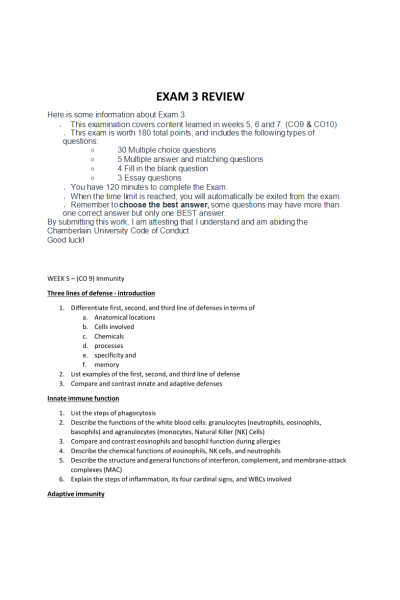BIOS 242 Week 8 EXAM 3 Review. Chapters 14-23 (excluding 16, 17)
-
$25.00
| Institution | BIOS 242 Fundamentals of Microbiology with Lab - Chamberlain |
| Contributor | Anika Fultz |
EXAM 3 REVIEW
Here is some information about Exam 3.
- This examination covers content learned in weeks 5, 6 and 7. (CO9 & CO10)
- This exam is worth 180 total points, and includes the following types of questions:
- 30 Multiple choice questions
- 5 Multiple answer and matching questions
- 4 Fill in the blank question
- 3 Essay questions
- You have 120 minutes to complete the Exam.
- When the time limit is reached, you will automatically be exited from the exam.
- Remember to choose the best answer, some questions may have more than one correct answer but only one BEST answer.
- This exam is worth 180 total points, and includes the following types of questions:
By submitting this work, I am attesting that I understand and am abiding the Chamberlain University Code of Conduct.
Good luck!
WEEK 5 – (CO 9) Immunity
Three lines of defense - introduction
- Differentiate first, second, and third line of defenses in terms of
- List examples of the first, second, and third line of defense
- Compare and contrast innate and adaptive defenses
Innate immune function
- List the steps of phagocytosis
- Describe the functions of the white blood cells: granulocytes (neutrophils, eosinophils, basophils) and agranulocytes (monocytes, Natural Killer [NK] Cells) ……… Continue
Adaptive immunity
- Differentiate humoral and cell-mediated immunity in terms of cells involved, functions of cells, location of maturation
- Summarize the five distinctive characteristics of the adaptive immune response
- Know the maturation locations of B cells and T cells, and where they are generally found after maturation
- Differentiate the terms antigens, epitopes, haptens, and antibodies……… Continue
WEEK 6 – (CO10) Microorganisms and diseases of skin, eyes, nervous system, cardiovascular and lymph
SKIN & EYES
- Describe the anatomy and physiology (including innate defenses) of skin & eyes
- List five innate defenses of the skin
- List common skin microorganisms (bacteria and fungi) that are also opportunistic pathogens
- Know the disease(s) caused by the microorganism(s) ……… Continue
NERVOUS SYSTEM
- Describe the anatomy and physiology of the nervous system
- Differentiate PNS from CNS, and define the term “axenic”
- Explain how pathogens can enter the CNS
- Know the disease(s) caused by the microorganism(s) ……… Continue
CARDIOVASCULAR AND LYMPHATIC SYSTEMS
- Describe the anatomy and physiology (including innate and adaptive defenses) of the cardiovascular and lymphatic systems
- Review the flow of blood through the cardiovascular system, and the part in which oxygen exchange takes place into tissues
- Differentiate the terms septicemia, toxemia, and bacteremia……… Continue
WEEK 7 – (CO10) Microorganisms and diseases of respiratory, GI, and urinary/reproductive
RESPIRATORY
- Describe the anatomy and physiology (including innate defenses) of respiratory system
- List four defenses of the respiratory system
- Identify the disease caused by the microorganism(s)
- Classify pathogens as virus, bacteria, fungi, helminth, protist, or prion……… Continue
GASTROINTESTINAL
- Describe the anatomy and physiology (including innate defenses and two categories of structures) of the gastrointestinal system
- List three defenses of the GI system
- Identify the disease caused by the microorganism(s)
- Classify pathogens as virus, bacteria, fungi, helminth, protist, or prion……… Continue
URINARY/REPRODUCTIVE
- Describe the anatomy and physiology (including innate defenses and two categories of structures) of the urinary and reproductive systems
- Identify the disease caused by the microorganism(s)
- Classify pathogens as virus, bacteria, fungi, helminth, protist, or prion……… Continue
ALL EXAM 3 DISEASES
Week 6 diseases:
- SKIN AND EYES
- NERVOUS
- CARDIOVASCULAR/LYMPH
Week 7 Diseases:
- Respiratory
- GI
- Genitourinary
| Instituition / Term | |
| Term | Uploaded 2023 |
| Institution | BIOS 242 Fundamentals of Microbiology with Lab - Chamberlain |
| Contributor | Anika Fultz |















































